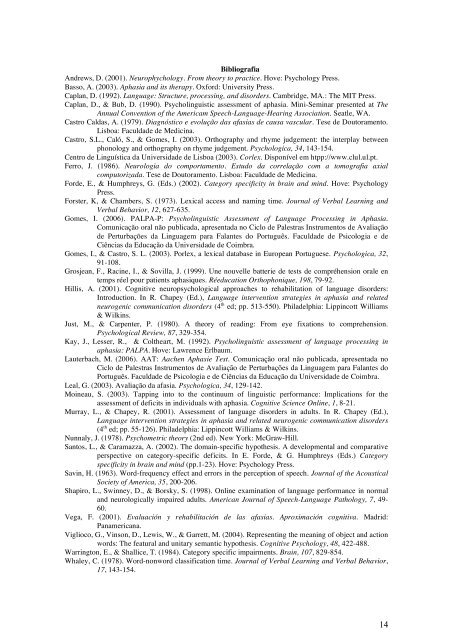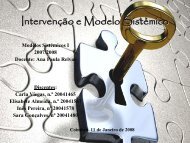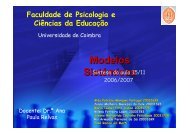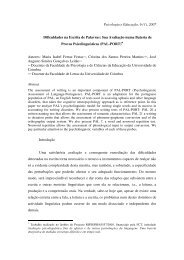In C. Machado, L. Almeida, A. Guisande, M. Gonçalves, V. Ramalho ...
In C. Machado, L. Almeida, A. Guisande, M. Gonçalves, V. Ramalho ...
In C. Machado, L. Almeida, A. Guisande, M. Gonçalves, V. Ramalho ...
You also want an ePaper? Increase the reach of your titles
YUMPU automatically turns print PDFs into web optimized ePapers that Google loves.
Bibliografia<br />
Andrews, D. (2001). Neurophychology. From theory to practice. Hove: Psychology Press.<br />
Basso, A. (2003). Aphasia and its therapy. Oxford: University Press.<br />
Caplan, D. (1992). Language: Structure, processing, and disorders. Cambridge, MA.: The MIT Press.<br />
Caplan, D., & Bub, D. (1990). Psycholinguistic assessment of aphasia. Mini-Seminar presented at The<br />
Annual Convention of the Americam Speech-Language-Hearing Association. Seatle, WA.<br />
Castro Caldas, A. (1979). Diagnóstico e evolução das afasias de causa vascular. Tese de Doutoramento.<br />
Lisboa: Faculdade de Medicina.<br />
Castro, S.L., Caló, S., & Gomes, I. (2003). Orthography and rhyme judgement: the interplay between<br />
phonology and orthography on rhyme judgement. Psychologica, 34, 143-154.<br />
Centro de Linguística da Universidade de Lisboa (2003). Corlex. Disponível em htpp://www.clul.ul.pt.<br />
Ferro, J. (1986). Neurologia do comportamento. Estudo da correlação com a tomografia axial<br />
computorizada. Tese de Doutoramento. Lisboa: Faculdade de Medicina.<br />
Forde, E., & Humphreys, G. (Eds.) (2002). Category specificity in brain and mind. Hove: Psychology<br />
Press.<br />
Forster, K, & Chambers, S. (1973). Lexical access and naming time. Journal of Verbal Learning and<br />
Verbal Behavior, 12, 627-635.<br />
Gomes, I. (2006). PALPA-P: Psycholinguistic Assessment of Language Processing in Aphasia.<br />
Comunicação oral não publicada, apresentada no Ciclo de Palestras <strong>In</strong>strumentos de Avaliação<br />
de Perturbações da Linguagem para Falantes do Português. Faculdade de Psicologia e de<br />
Ciências da Educação da Universidade de Coimbra.<br />
Gomes, I., & Castro, S. L. (2003). Porlex, a lexical database in European Portuguese. Psychologica, 32,<br />
91-108.<br />
Grosjean, F., Racine, I., & Sovilla, J. (1999). Une nouvelle batterie de tests de compréhension orale en<br />
temps réel pour patients aphasiques. Réeducation Orthophonique, 198, 79-92.<br />
Hillis, A. (2001). Cognitive neuropsychological approaches to rehabilitation of language disorders:<br />
<strong>In</strong>troduction. <strong>In</strong> R. Chapey (Ed.), Language intervention strategies in aphasia and related<br />
neurogenic communication disorders (4 th ed; pp. 513-550). Philadelphia: Lippincott Williams<br />
& Wilkins.<br />
Just, M., & Carpenter, P. (1980). A theory of reading: From eye fixations to comprehension.<br />
Psychological Review, 87, 329-354.<br />
Kay, J., Lesser, R., & Coltheart, M. (1992). Psycholinguistic assessment of language processing in<br />
aphasia: PALPA. Hove: Lawrence Erlbaum.<br />
Lauterbach, M. (2006). AAT: Aachen Aphasie Test. Comunicação oral não publicada, apresentada no<br />
Ciclo de Palestras <strong>In</strong>strumentos de Avaliação de Perturbações da Linguagem para Falantes do<br />
Português. Faculdade de Psicologia e de Ciências da Educação da Universidade de Coimbra.<br />
Leal, G. (2003). Avaliação da afasia. Psychologica, 34, 129-142.<br />
Moineau, S. (2003). Tapping into to the continuum of linguistic performance: Implications for the<br />
assessment of deficits in individuals with aphasia. Cognitive Science Online, 1, 8-21.<br />
Murray, L., & Chapey, R. (2001). Assessment of language disorders in adults. <strong>In</strong> R. Chapey (Ed.),<br />
Language intervention strategies in aphasia and related neurogenic communication disorders<br />
(4 th ed; pp. 55-126). Philadelphia: Lippincott Williams & Wilkins.<br />
Nunnaly, J. (1978). Psychometric theory (2nd ed). New York: McGraw-Hill.<br />
Santos, L., & Caramazza, A. (2002). The domain-specific hypothesis. A developmental and comparative<br />
perspective on category-specific deficits. <strong>In</strong> E. Forde, & G. Humphreys (Eds.) Category<br />
specificity in brain and mind (pp.1-23). Hove: Psychology Press.<br />
Savin, H. (1963). Word-frequency effect and errors in the perception of speech. Journal of the Acoustical<br />
Society of America, 35, 200-206.<br />
Shapiro, L., Swinney, D., & Borsky, S. (1998). Online examination of language performance in normal<br />
and neurologically impaired adults. American Journal of Speech-Language Pathology, 7, 49-<br />
60.<br />
Vega, F. (2001). Evaluación y rehabilitación de las afasias. Aproximación cognitiva. Madrid:<br />
Panamericana.<br />
Viglioco, G., Vinson, D., Lewis, W., & Garrett, M. (2004). Representing the meaning of object and action<br />
words: The featural and unitary semantic hypothesis. Cognitive Psychology, 48, 422-488.<br />
Warrington, E., & Shallice, T. (1984). Category specific impairments. Brain, 107, 829-854.<br />
Whaley, C. (1978). Word-nonword classification time. Journal of Verbal Learning and Verbal Behavior,<br />
17, 143-154.<br />
14








